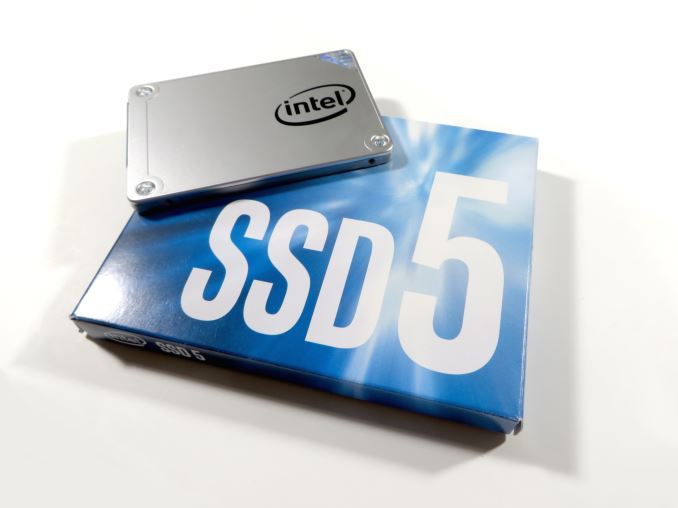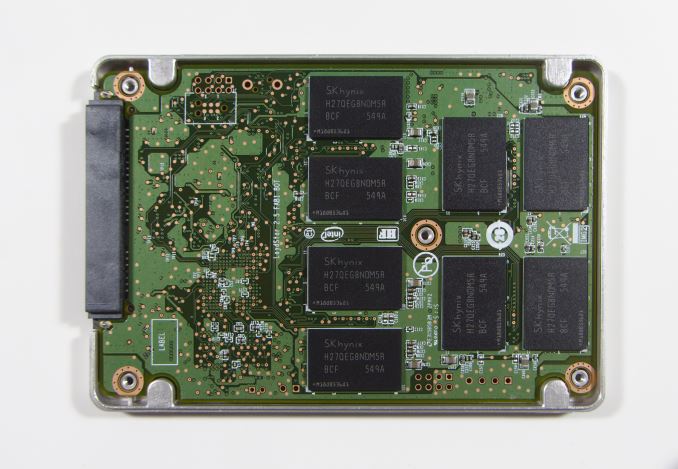The Intel SSD 540s (480GB) Review
by Billy Tallis on June 23, 2016 9:00 AM EST
Every few years, Intel releases a new SSD controller that raises the bar for the whole industry. In between those shake-ups, the competition catches up and surpasses Intel. This pattern is especially pronounced in the consumer SSD market where Intel's mostly enterprise-focused chips cannot keep pace with the constant price cuts. During those interim years Intel turns to third-party controllers to fill the gaps in the product line that their own controllers cannot serve.
This year, Intel's decision to release an affordable mainstream SATA SSD has led them to use a Silicon Motion controller. But "affordable" by today's standards means using 15/16nm TLC NAND flash, and Intel doesn't make that either. They chose not to invest in the 16nm node at IMFT (their flash manufacturing partnership with Micron) so Intel has to buy their flash on the open market.
The result is the Intel 540s, using Silicon Motion's new SM2258 controller and SK Hynix 16nm TLC NAND. The SM2258 controller is the successor to the SM2256, Silicon Motion's first controller designed for use with TLC flash. SM2258 builds on that design by moving from 55nm fabrication to 40nm and incorporating several hardware tweaks including more flexible SLC caching and support for 3D NAND.
The Hynix TLC used in the Intel 540s is the same NAND that is inside the ADATA Premier SP550, one of two products we've tested that use the SM2256 controller. This gives us the opportunity to directly observe what's improved with Silicon Motion's controller and firmware since last year. The price history of the ADATA SP550 also shows that Intel should be able to make the 540s a very affordable product. It also appears that Intel has retired the use of 3xx model numbers to designate entry-level SSDs and all such models are now classified as legacy products.
| Intel SSD 540s Specifications | ||||||
| Capacity | 120GB | 180GB | 240GB | 360GB | 480GB | 1000GB |
| Controller | Silicon Motion SM2258 | |||||
| NAND Flash | SK Hynix 16nm TLC | |||||
| Sequential Read | 560MB/s | |||||
| Sequential Write | 400MB/s | 475MB/s | 480MB/s | |||
| Random Read IOPS | 60k | 71k | 74k | 78k | ||
| Random Write IOPS | 50k | 85k | ||||
| TCG Opal Encryption | No | |||||
| Power Management | Slumber and DevSleep | |||||
| Form Factor | 2.5" 7mm and M.2 2280 | |||||
| Warranty | 5 years | |||||
| Recommended Customer Price | $64 | $79 | $99 | $139 | $174 | $344 |
The 540s has Intel's typical aluminum casing housing a full-size PCB. Our 480GB sample had 16 packages each with two dies of the SK Hynix TLC. The new SM2258 controller uses the same 14mm x 14mm package as the SM2256, with a single external DRAM package next to it. As is typical for low-cost consumer drives, there are no power loss protection capacitors. There is a thermal pad between the controller and the case, something we saw for the SM2256 on the Crucial BX200 but not the ADATA SP550.
The PCB also bears the "Loyd Star" codename which the 540s shares with Intel's SSD E 5400s for the embedded market and the SSD DC S3100 for the enterprise market. The E 5400s covers only small capacities, ranging from 48GB to 180GB while the 540s is available in capacities from 120GB to 1000GB and the DC S3100 covers 180GB to 1000GB. All three product lines include some in-between sizes that are uncommon to find on modern drives. The 540s and E5400s are both available as 2.5" or M.2 drives while the DC S3100 is only available as a 2.5" drive.
For this review, the Intel 540s will primarily be compared against the two SM2256 products we've tested: the ADATA Premier SP550 and the Crucial BX200. The latter shipped with poorly-tuned firmware that made it a disappointment all around, but the former has been a relatively successful budget drive by offering acceptable performance at some of the best prices on the market. The Intel 540s is positioned slightly higher in the market due to carrying a 5-year warranty compared to three years for most budget TLC drives, but in terms of performance that's what it is competing against.
Other important drives to compare against will include the Toshiba OCZ Trion 150, a higher-performing drive using a controller based on the Phison S10 paired with Toshiba 15nm TLC, and the SanDisk X400 using Marvell's 88SS1074 controller and SanDisk's 15nm TLC. The SanDisk X400 seems to be the fastest planar TLC drive on the market, and it is available in both 2.5" and single-sided M.2 form factors. The SanDisk X400 also has a 5-year warranty.
| AnandTech 2015 SSD Test System | |
| CPU | Intel Core i7-4770K running at 3.5GHz (Turbo & EIST enabled, C-states disabled) |
| Motherboard | ASUS Z97 Pro (BIOS 2701) |
| Chipset | Intel Z97 |
| Memory | Corsair Vengeance DDR3-1866 2x8GB (9-10-9-27 2T) |
| Graphics | Intel HD Graphics 4600 |
| Desktop Resolution | 1920 x 1200 |
| OS | Windows 8.1 x64 |
- Thanks to Intel for the Core i7-4770K CPU
- Thanks to ASUS for the Z97 Deluxe motherboard
- Thanks to Corsair for the Vengeance 16GB DDR3-1866 DRAM kit, RM750 power supply, Carbide 200R case, and Hydro H60 CPU cooler












77 Comments
View All Comments
cbjwthwm - Tuesday, June 28, 2016 - link
I'll pay a premium vs a generic like the SP550 because:1. Intel will undoubtedly manufacture the drive to reliable standards
2. it will be supported by a decent toolbox utility (eg: ADATA's is buggy junk)
3. Intel will rake SMI's controller firmware over the coals, like it did with Sandforce--an update has already been released since this review
4. its firmware update process will be simple & reliable
I picked up an SP550 for eval which eventually needed a firmware update. After experiencing the SP550's nasty firmware update process (a disorganized DIY mess), I now use BX200's as the cheapest drive choice simply because firmware updates are competently packaged. I've also had scenarios where fully updated OCZ Trions had terrible stuttering, and imaging to a BX200 solved the issue as well.
I see Intel's 540s as the combination of what the SMI-based TLC products like the SP550 and BX200 should be, if you combine their positive attributes (beyond price)--and for light load applications those benefits could sway me away from equivalently priced MLC-based drives with similar support issues and potential reliability compromises.
Samsung also has crappy firmware support (eg: the repeated 840 EVO performance fixes, and the 850 series update bricking issues which were pulled) so I rarely ever use them. Samsung may have an engineering lead, but they have a well established history as a consistently reckless company when it comes to support.
vladx - Tuesday, June 28, 2016 - link
Another idiot spreading FUD about Samsung. 840 EVO works great and as new after applying the fix. Stuff like the trash you posted starts stupid myths that average joes keep repeating.cbjwthwm - Wednesday, June 29, 2016 - link
Myths? There is an established track record with them, widely reported and easy to find.1. Multiple rounds of 840 EVO firmware: http://www.anandtech.com/show/9196/samsung-release...
2. 850 firmware pulled, and the ISOs were never re-released: http://www.guru3d.com/news-story/after-samsung-840...
fanofanand - Thursday, June 30, 2016 - link
The evo issue was legitimate. That said, it isn't like Intel hasn't released a few turds in their day as well. Between broken AVX and numerous other problems, Intel is not the holy grail of perfection and quality control. Samsung has at least as strong a track record for reliability with their drives as Intel, so it makes no sense to purchase this over the comparatively priced Samsung drive. You reference "premium vs generic" but line this up in the premium vs premium space and you will find this drive underperforms and is overpriced. You are either an Intel shareholder, employee, or don't use critical thinking when it comes to your beloved brand.vladx - Thursday, June 30, 2016 - link
There were issues which they fixed. I call that great support from Samsung. It's FUD to say Samsung has a bad history based on fixed issues.Prof-Q - Tuesday, August 16, 2016 - link
If Intel 540 and Adata SP550 used the same NAND, then why Intel's performance is so much better in UsersBenchmark?I was about to buy Intel but this article made me reconsider the options
SeanJ76 - Tuesday, October 4, 2016 - link
Intel will still be the king of SSD's, their top tier is no 1 in speed and reliability(Pci-e) version, their mid tier is holding their own as well, and their entry level tier, 540 series, is so damn affordable for the reliability who wouldn't buy them? I own 4 Intel 520/535 series currently, 2 of them are over 5 yrs old and they are still at 100% life span according to Intel's Toolbox. The main difference in brands is reliability, now that they're all pretty much on par with speed, you should go with the reliability winner which is none other than INTEL!